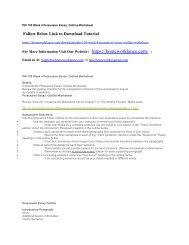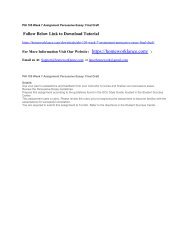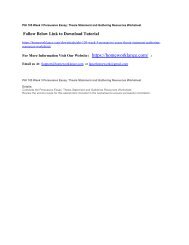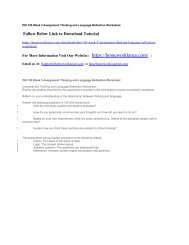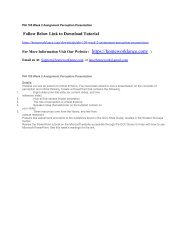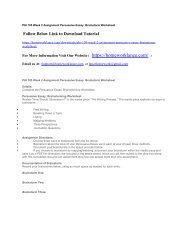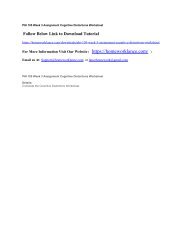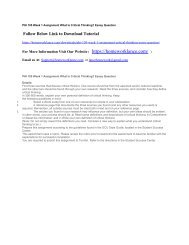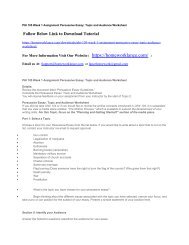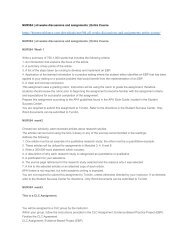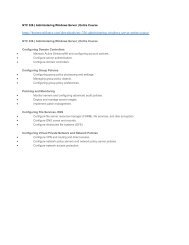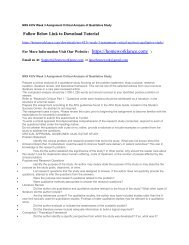NRS 437V Ethical Decision Making in Health Care Entire Course
Create successful ePaper yourself
Turn your PDF publications into a flip-book with our unique Google optimized e-Paper software.
<strong>NRS</strong> <strong>437V</strong> <strong>Ethical</strong> <strong>Decision</strong> <strong>Mak<strong>in</strong>g</strong> <strong>in</strong> <strong>Health</strong> <strong>Care</strong> <strong>Entire</strong> <strong>Course</strong><br />
Follow Below L<strong>in</strong>k to Download Tutorial<br />
https://homeworklance.com/downloads/nrs-437v-ethical-decision-mak<strong>in</strong>g-health-care-entire-course/<br />
For More Information Visit Our Website ( https://homeworklance.com/ )<br />
Email us At: Support@homeworklance.com or lancehomework@gmail.com<br />
<strong>NRS</strong> <strong>437V</strong> <strong>Ethical</strong> <strong>Decision</strong> <strong>Mak<strong>in</strong>g</strong> <strong>in</strong> <strong>Health</strong> <strong>Care</strong> <strong>Entire</strong> <strong>Course</strong><br />
<strong>NRS</strong> <strong>437V</strong> Week 1 DQ 1<br />
Many situations can raise ethical concerns, particularly <strong>in</strong> the face of disagreement and conflict between parties.<br />
However, not all situations of an ethical nature result <strong>in</strong> values conflict or constitute an ethical dilemma. Expla<strong>in</strong> the<br />
characteristics of an ethical dilemma. How do they differ from other situations result<strong>in</strong>g <strong>in</strong> disagreement between<br />
conflict<strong>in</strong>g preferences, needs, or expectations?<br />
<strong>NRS</strong> <strong>437V</strong> Week 1 DQ 2<br />
Consider the age-old tale of the father who stole a loaf of bread to feed his hungry family. Steal<strong>in</strong>g is deemed wrong<br />
by our society and is punishable by law. Fail<strong>in</strong>g to provide for one’s family is neglectful and fundamentally wrong.<br />
What would be the dilemma and the implications of such a crime on the <strong>in</strong>dividual, the family, the community, and<br />
society?<br />
<strong>NRS</strong> <strong>437V</strong> Week 1 Assignment My Nurs<strong>in</strong>g Ethics<br />
After read<strong>in</strong>g the Topic 1 materials, complete the questionnaire titled, “My Nurs<strong>in</strong>g Ethic.”<br />
Complete the questions below:<br />
PASSION: Why am I here?<br />
MOTIVATION: What moves me to act?<br />
INSPIRATION: What keeps me <strong>in</strong> motion?<br />
LOYALTY: Whom do I serve?<br />
Us<strong>in</strong>g the read<strong>in</strong>g and the questionnaire, write a paper of 750-1,000 words <strong>in</strong> which you describe your professional<br />
moral compass. As you write your paper, <strong>in</strong>clude the follow<strong>in</strong>g:<br />
What personal, cultural, and spiritual values contribute to your worldview and philosophy of nurs<strong>in</strong>g? How do these<br />
values shape or <strong>in</strong>fluence your nurs<strong>in</strong>g practice?<br />
Def<strong>in</strong>e values, morals, and ethics <strong>in</strong> the context of your obligation to nurs<strong>in</strong>g practice. Expla<strong>in</strong> how your personal<br />
values, philosophy, and worldview may conflict with your obligation to practice, creat<strong>in</strong>g an ethical dilemma.<br />
Reflect and share your own personal thoughts regard<strong>in</strong>g the morals and ethical dilemmas you may face <strong>in</strong> the health<br />
care field. How do your personal views affect your behavior and your decision mak<strong>in</strong>g?<br />
Do not be concerned with the use of ethical term<strong>in</strong>ology for this paper.<br />
Prepare this assignment accord<strong>in</strong>g to the APA guidel<strong>in</strong>es found <strong>in</strong> the APA Style Guide, located <strong>in</strong> the Student<br />
Success Center. An abstract is not required.<br />
This assignment uses a rubric. Please review the rubric prior to beg<strong>in</strong>n<strong>in</strong>g the assignment to become familiar with the<br />
expectations for successful completion.<br />
You are required to submit this assignment to Turnit<strong>in</strong>. Please refer to the directions <strong>in</strong> the Student Success Center<br />
<strong>NRS</strong> <strong>437V</strong> Week 2 DQ 1<br />
How do personal values, morals, and ethics <strong>in</strong>fluence decision mak<strong>in</strong>g? (Consider your upbr<strong>in</strong>g<strong>in</strong>g, your family<br />
structure, your socioeconomic status, your community, and your own personal experiences). How do these factors<br />
<strong>in</strong>fluence your decisions? How might they conflict with the needs, preferences, and biases of your patients and their<br />
families? Which ethical theoretical framework best describes your personal worldview? Support your response with<br />
examples.<br />
<strong>NRS</strong> <strong>437V</strong> Week 2 DQ 2
Read the assigned article, “Deal<strong>in</strong>g With Futile Treatment: A Medical Student’s Perspective.” How does the author<br />
describe futile treatment? What ethical dilemmas are faced by health care providers who must address human<br />
suffer<strong>in</strong>g? How can ethical pr<strong>in</strong>ciples be used to identify the most appropriate decision when conflict arises?<br />
What ethical dilemmas are faced by health care providers who must address human suffer<strong>in</strong>g?<br />
How can ethical pr<strong>in</strong>ciples be used to identify the most appropriate decision when conflict arises?<br />
<strong>NRS</strong> <strong>437V</strong> Week 3 DQ 1<br />
Uustal (1993) proposed a decision-mak<strong>in</strong>g model that provides concrete steps <strong>in</strong> which to arrive at a morally<br />
acceptable solution when faced with an ethical dilemma. What type of an ethical dilemma have you encountered <strong>in</strong><br />
the cl<strong>in</strong>ical sett<strong>in</strong>g? How can the decision-mak<strong>in</strong>g model identified by Uustal be applied to this situation? Be specific<br />
when describ<strong>in</strong>g each of the n<strong>in</strong>e steps.<br />
<strong>NRS</strong> <strong>437V</strong> Week 3 DQ 2<br />
How do a nurse’s fundamental duties, as described by the Hippocratic Oath and Night<strong>in</strong>gale Pledge, <strong>in</strong>fluence a<br />
nurse’s practice and decision mak<strong>in</strong>g?<br />
<strong>NRS</strong> <strong>437V</strong> Week 3 Assignment Apply<strong>in</strong>g <strong>Ethical</strong> Frameworks <strong>in</strong> Practice<br />
Details:<br />
Us<strong>in</strong>g the steps outl<strong>in</strong>ed <strong>in</strong> the decision-mak<strong>in</strong>g models <strong>in</strong> your read<strong>in</strong>gs, select one ethical decision-mak<strong>in</strong>g model<br />
and use the model to analyze the case provided.<br />
Case Scenario:<br />
A 6-year-old develops a high fever accompanied by violent vomit<strong>in</strong>g and convulsions while at school. The child is<br />
rushed to a nearby hospital. The attend<strong>in</strong>g physician makes a diagnosis of men<strong>in</strong>gitis and requests permission to<br />
<strong>in</strong>itiate treatment from the parents. The child’s parents are divorced. The mother, who is not the biological parent of<br />
the child, has primary custody. She is a Christian Scientist who <strong>in</strong>sists that no medical treatment be offered for<br />
religious reasons. The biological father, who resides <strong>in</strong> another state, is also contacted. He <strong>in</strong>sists that treatment be<br />
given and seeks <strong>in</strong>dependent consultation from another physician.<br />
Assignment:<br />
In a formal, written paper of 800-1,200 words, answer the follow<strong>in</strong>g questions:<br />
1. What is the ethical dilemma here?<br />
2. Describe the decision-mak<strong>in</strong>g model you selected from your read<strong>in</strong>gs.<br />
3. How would you resolve this dilemma us<strong>in</strong>g the model?<br />
4. Include, at the end of your paper, a 200-word dialog <strong>in</strong> which you expla<strong>in</strong> your decision to the family.<br />
(Remember to use language that the family would understand).<br />
A m<strong>in</strong>imum of three references must be used.<br />
Prepare this assignment accord<strong>in</strong>g to the APA guidel<strong>in</strong>es found <strong>in</strong> the APA Style Guide, located <strong>in</strong> the Student<br />
Success Center. An abstract is not required.<br />
This assignment uses a rubric. Please review the rubric prior to beg<strong>in</strong>n<strong>in</strong>g the assignment to become familiar with the<br />
expectations for successful completion.<br />
You are required to submit this assignment to Turnit<strong>in</strong>. Please refer to the directions <strong>in</strong> the Student Success Center.<br />
Only Word documents can be submitted to Turnit<strong>in</strong>.<br />
<strong>NRS</strong> <strong>437V</strong> Week 4 DQ 1<br />
Does the pr<strong>in</strong>ciple of autonomy guarantee a person the right to do someth<strong>in</strong>g that is harmful to oneself? To others?<br />
Expla<strong>in</strong> your response with ethical rationale.<br />
<strong>NRS</strong> <strong>437V</strong> Week 4 DQ 2<br />
What is the difference between beneficence and nonmaleficence? Give examples of each from your cl<strong>in</strong>ical practice.<br />
<strong>NRS</strong> <strong>437V</strong> Week 4 ass<strong>in</strong>gment Analysis of an <strong>Ethical</strong> Dilemma (Part One)<br />
Details:<br />
Refer to the “Collaborative Learn<strong>in</strong>g Community: Analysis of an <strong>Ethical</strong> Dilemma” resource for the dilemmas and<br />
resources that will be used for this multi-part Analysis of an <strong>Ethical</strong> Dilemma assignment. Part ONE is an <strong>in</strong>dividual<br />
assignment that will also be used <strong>in</strong> Part TWO, the culm<strong>in</strong>at<strong>in</strong>g paper.
For this <strong>in</strong>dividual assignment, <strong>in</strong>terview a hospital adm<strong>in</strong>istrator, a spiritual leader, a health care colleague, or a<br />
neighbor/friend.<br />
In your <strong>in</strong>terview, ask about the <strong>in</strong>dividual’s philosophy and worldview <strong>in</strong> relation to the ethical dilemma of your<br />
choos<strong>in</strong>g, which was:<br />
[[ Dilemma 3: Voluntary/Assisted Euthanasia<br />
Confront<strong>in</strong>g Death: Who Chooses? Who Controls? A Dialogue between Dax Cowart and Robert Burt<br />
http://digitalcommons.law.yale.edu/fss_papers/706/<br />
The Terry Schiavo Documentary http://www.youtube.com/watch?v=cki55BM42kw ]]<br />
Individually, you will need to <strong>in</strong>terview all 4 (four) different <strong>in</strong>dividuals and perspectives to complete Part Three of the<br />
Analysis of an <strong>Ethical</strong> Dilemma assignment.<br />
Make sure all roles are covered.<br />
Craft a 250-500-word summary of the <strong>in</strong>dividual’s response, <strong>in</strong>clud<strong>in</strong>g the <strong>in</strong>dividual’s identified philosophy and<br />
worldview.<br />
APA format is not required, but solid academic writ<strong>in</strong>g is expected<br />
<strong>NRS</strong> <strong>437V</strong> Week 5 DQ 1<br />
What is the ethical dilemma?<br />
What is your value and ethical position related to the case? Include discussion of theory and pr<strong>in</strong>ciples on which your<br />
position is based.<br />
What are some other alternatives for resolv<strong>in</strong>g the problem?<br />
What are the possible consequences for those acceptable alternatives?<br />
How would you prioritize the acceptable alternatives?<br />
What is your plan of action?<br />
<strong>NRS</strong> <strong>437V</strong> Week 5 DQ 1<br />
<strong>Health</strong> care providers are obligated to provide for those entrusted <strong>in</strong> their care. To what extent do they meet this<br />
obligation? How might their obligation to others conflict with their obligation to themselves?<br />
<strong>NRS</strong> <strong>437V</strong> Week 5 Assignment Analysis of an <strong>Ethical</strong> Dilemma (Part Two)<br />
Details:<br />
This is a CLC assignment.<br />
Refer to the “Collaborative Learn<strong>in</strong>g Community: Analysis of an <strong>Ethical</strong> Dilemma” resource for the dilemmas and<br />
resources that will be used for this multi-part assignment.<br />
After complet<strong>in</strong>g the <strong>in</strong>dividual <strong>in</strong>terviews (Part ONE), share your <strong>in</strong>terview results. Consider the responses of the four<br />
types of <strong>in</strong>dividuals <strong>in</strong>terviewed. Assess their similarities and differences.<br />
Compose a written recommendation of 750-1,000 words. Incorporate the research YOU HAVE done as well as your<br />
<strong>in</strong>terview results for the four types of <strong>in</strong>dividuals to come to a resolution to the ethical dilemma. Be sure to clearly<br />
articulate your position and the rationale for your position.<br />
Prepare this assignment accord<strong>in</strong>g to the APA guidel<strong>in</strong>es found <strong>in</strong> the APA Style Guide, located <strong>in</strong> the Student<br />
Success Center. An abstract is not required.<br />
This assignment uses a rubric. Please review the rubric prior to beg<strong>in</strong>n<strong>in</strong>g the assignment to become familiar with the<br />
expectations for successful completion.<br />
You are required to submit this assignment to Turnit<strong>in</strong>.<br />
<strong>NRS</strong> <strong>437V</strong> Week 5 Assignment Analysis of an <strong>Ethical</strong> Dilemma (Part Three)<br />
This is a CLC assignment.<br />
Refer to the “Collaborative Learn<strong>in</strong>g Community: Analysis of an <strong>Ethical</strong> Dilemma” resource for the dilemmas and<br />
resources that will be used for this multi-part assignment.<br />
After complet<strong>in</strong>g the <strong>in</strong>dividual <strong>in</strong>terviews (Part Two), share your <strong>in</strong>terview results. As a group, consider the<br />
responses of the four types of <strong>in</strong>dividuals <strong>in</strong>terviewed. Assess their similarities and differences.<br />
Compose a written recommendation of 750-1,000 words. Incorporate the research your group has done as well as<br />
your <strong>in</strong>terview results for the four types of <strong>in</strong>dividuals to come to a resolution to the ethical dilemma. Be sure to clearly<br />
articulate your group’s position and the rationale for your position.<br />
Prepare this assignment accord<strong>in</strong>g to the APA guidel<strong>in</strong>es found <strong>in</strong> the APA Style Guide, located <strong>in</strong> the Student<br />
Success Center. An abstract is not required.<br />
This assignment uses a rubric. Please review the rubric prior to beg<strong>in</strong>n<strong>in</strong>g the assignment to become familiar with the<br />
expectations for successful completion.<br />
You are required to submit this assignment to Turnit<strong>in</strong>. Please refer to the directions <strong>in</strong> the Student Success Center.





